Victorian gothic style triptych reredos restored by Halford Restorations
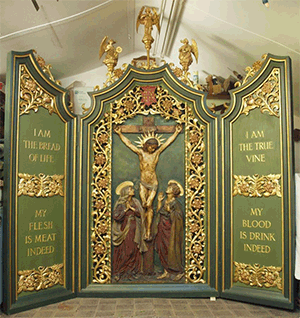 This is a decorated screen originally mounted behind the alter within the chapel of Hockerill college Bishop's Stortford. It is in triptych form, i.e. made up of three panels and is quite typical in such that the panels are hinged to close in on itself.
This is a decorated screen originally mounted behind the alter within the chapel of Hockerill college Bishop's Stortford. It is in triptych form, i.e. made up of three panels and is quite typical in such that the panels are hinged to close in on itself.
The central screen of the reredos (pronounced "rear-dos") comprises a plaster panel depicting Jesus on the cross with presumably Mary and John, the 'Titulus' inscribed INRI above Jesus :Latin, Iesvs Nazarenvs Rex Ivdaeorvm (Jesus of Nazareth King of the Jews ).
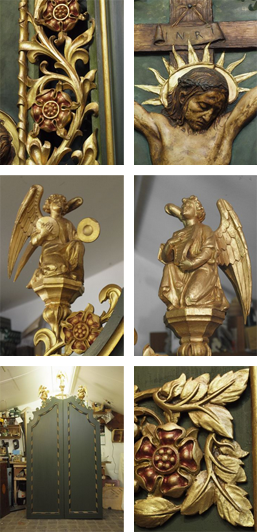 This panel is surrounded by carved gilt 'rose' vine foliage with Tudor type roses and buds.
This panel is surrounded by carved gilt 'rose' vine foliage with Tudor type roses and buds.
With a central asymmetric shield with the letters IHS ; a commonly used Christian symbol with a number of meanings : the first three letters of Jesus' name in Greek , & the abbreviations of the following Latin : "Iesus Hominum Salvator " (Jesus savior of humankind) , "In Hoc Signo" (in this sign you shall conquer) " in hac salus" (in this cross is salvation).
This is mounted in a moulded frame with gilt cavetto & 3/4 round moulding, the top being a five centred inflexed arch mounted with more scrolled foliage & roses and carved angels with instruments upon pedestals.
The two panels either side have the same profile and frame as the centre, but effectively in two halves, hinged to cover the central panel or open out to reveal the whole reredos, these have applied carved panels (missing) and the text "I am the true vine", "My blood is drink indeed", "I am the bread of life" , "My flesh is meat indeed".
The college buildings, along with the first All Saints church close by, were built in 1852, designed by the influential architect Joseph Clark who incorporated gothic revival designs into work for several dioceses, designing many schools and ecclesiastical buildings. The chapel was added later being opened by the Bishop of St Albans in 1878 and it is likely that the reredos was built for the chapel at the time, possibly even designed by Joseph Clarke.
Joseph Clarke is recorder as designing the reredos at Foxearth church Essex although there are also very close similarities with detail in the Reredos at Bury Parish church Lancashire designed by J Harold- Gibbons.
Below are some photographs illustrating the condition before restoration and some of the restoration processes

Although the above photos clearly illustrate the general poor condition, the extent of the damage was much worse, with some being revealed only after cleaning.
Much of the framework and joints were loose, partially due to degradation of the glue and drying of the wood. The two outer frames being detached for many years with the hinges missing, and generally many small breaks and problems with the structure. Restoring the integrity of the frames was the first priority; the whole reredos as can be seen below, was first careful dismantled into its component parts.
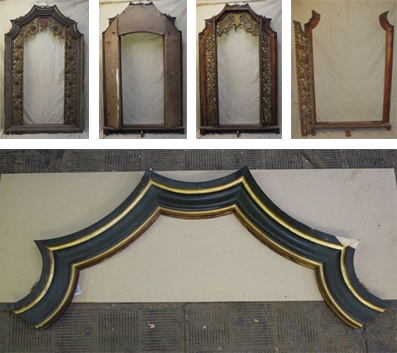
The inflexed arch frame top, shown above re joined together, is skilfully made with the mitred joints being curved to allow for the correct alignment of the mouldings, if time permitted it would be interesting to work out the geometry behind the design. This exact alignment meant that few adjustments could be made within the joints to cope with some of the distortions present. Hence much work was involved in trial assembly in order to make any possible adjustments to allow the triptych to work effectively when open and closed.
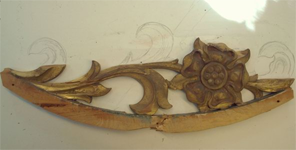 One of nine sections of carving attached to the tops of each triptych frame.
One of nine sections of carving attached to the tops of each triptych frame.
Much of these are partially or completely missing but this shows the remains of one. The design of the missing areas of carving are here being sketched.
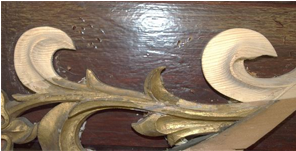 The majority of the timber used in the reredos is pine, including all carved areas accept for the four missing lower carvings on the outer panels (above and below the script) a remnant of these remains and is of lime, the most favoured timber for carving.
The majority of the timber used in the reredos is pine, including all carved areas accept for the four missing lower carvings on the outer panels (above and below the script) a remnant of these remains and is of lime, the most favoured timber for carving.
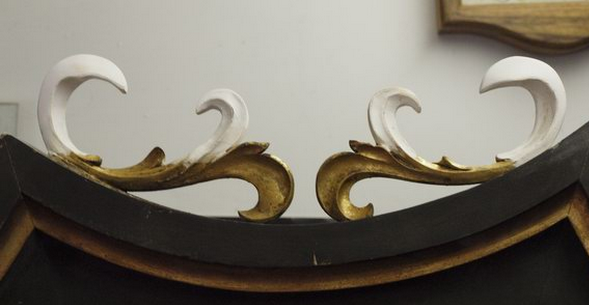
The quality of gilding is not and would not have needed to be perfect, this coupled with the aged and discoloured lacquer coat sealing the gilt and the build up of dust gave a very good impression of a simple painted finish, however, after initial cleaning we were delighted to find that it was indeed oil gilt. Unfortunately, unlike water gilding, it is not wise to attempt too much 'chemical' cleaning of the oil gilding as whatever may remove discoloured lacquers will equally well damage the oil gilding beneath. The repairs therefore required blending in creating a finish to match the existing aged gilding, a perfect fresh oil gilt finish would be inappropriate, so the replacement parts will be partially gilt and toned down to match.
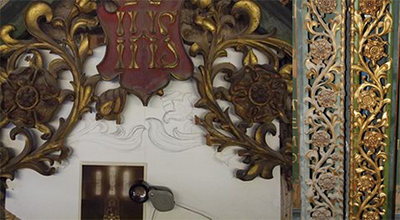
Above can be seen the missing areas below the IHS shield, these are hinted at in an old photo-postcard, the only available picture of the reredos still in the chapel (although it seems even at this date the carvings in the two sides of the triptych or missing) Along side this can be seen before and after cleaning of the scrolled rose vine carving.
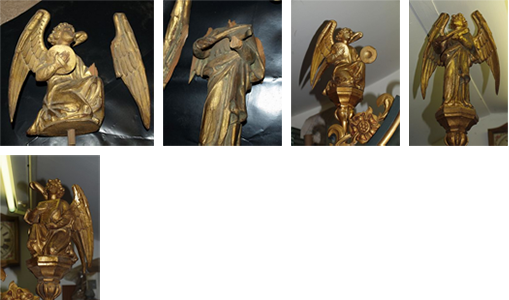
The angels, long broken from their original positions had broken wings and missing parts including wing parts, a head, hand and violin parts and one of the pedestals. Above can be seen some of the damage and then the angels nearing completion.
With regards to all missing parts on the reredos, some require new carving from replacement wood carved by hand using carving chisels/gouges. Some are more effectively copied using silicone moulds and creating a casting, this is of course only possible if there is an identical existing piece, not even a mirror image can be made from a mould. In some instances it is important to use exact matching materials and techniques, in others the deception need not run so deep if a more effective or efficient technique can create near identical results.
Below can be seen the biggest problem with the reredos; several areas of completely missing carvings. Clues obviously are present as to the general outline of the designs however even this is misleading as the carvings are undercut such that the imprint seen is not a true shadow of the carving but only a contact area. The upper carvings are clearly more in common with the scrolled vine and rose design elsewhere, and so can be designed based on this, however the lower four areas judging from the small remnant and other clues is slightly finer and of a different design of foliage but likely still to have the Tudor type rose featured.
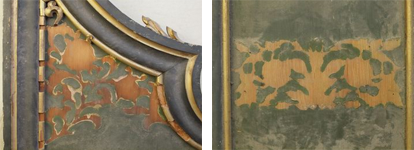
Below showing some of the potential designs for the missing carvings and right showing one of the topmost carvings, remade, gilded, partially toned but yet to receive a red tint within the Tudor rose as present on the existing examples.
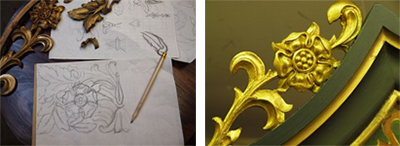
Below, progress nearly up to date, part way through the restoration of the paint finish. I will update this soon with the latest progress, and more details of the processes involved.

Left: central plaster panel before cleaning.
Right: Trial fitting of the central plaster panel.

Missing areas of carving replaced, these have been carved from lime wood, glued into place, further carving to blend in, with a coating of gesso in order to refine the finish before gilding.
The design is based on what is evident from an old photo and in comparison to the surrounding design. This is then oil gilt and toned down closer to the surrounding gilt, yet to be finished.

The lettering is in relief, each originally being cast in a type of plaster or composition and being glued onto the surface. Missing areas of lettering are built up with successive coats of gesso and blended in.
Carving in progress. Above and left are portions of the carving for the top right panel.
The outline is transcribed onto the lime wood blanks, which are then cut out on a fine bladed band saw. The raw shapes are then glued to blocks of MDF in order to secure the piece for working on, then the detail drawn onto the surface and the carving carried out using a variety of carving chisels and gouges.
Once finished the carving will be cut from the block and trimmed to the required thickness, the reverse side can then be carved with a simple undercut/bevel, then prepared for the gilding process.

New carvings trial fitted prior to gilding.
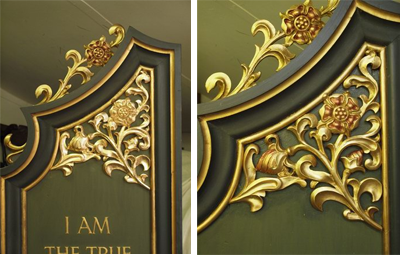
Above. Oil gilding completed, before and after toning the gilding to match the original, this has already been done to the carving on top of the frame, as can be seen, along with the red tint added to the rose.
Much of the original gilding was likely to have been of a brighter finish, but due to degradation and discolouration of the sealing coat of lacquer it has become dulled over time. This cannot be removed or cleaned to any greater extent without damaging the gilding below.
This is called 'oil gilding' due to the use of an oil based lacquer applied to the surface, at the point where this is almost dry, and has just a small degree of tack left to the surface, the gold leaf is applied.
Water gilding is a different and more involved process which requires careful preparation and can take a burnish afterwards to achieve a high degree of shine and that true solid gold effect.
Instead of an oil based method of attaching the gold leaf, a water based 'size' is used and this can be much more resilient to the use of solvents and 'strippers' to remove later or damaged over coatings.
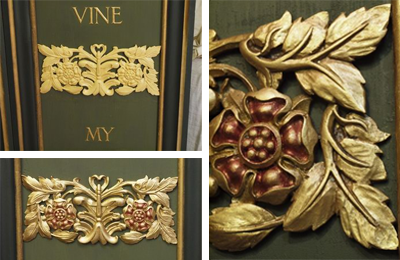
Here can be seen one of the replacements for the four missing lower carvings, compare this to the sketches seen further up this page. Left just finished in a pale yellow ochre finish ready for gilding and right gilding toning etc finished.
For more information visit www.halfordrestorations.co.uk













